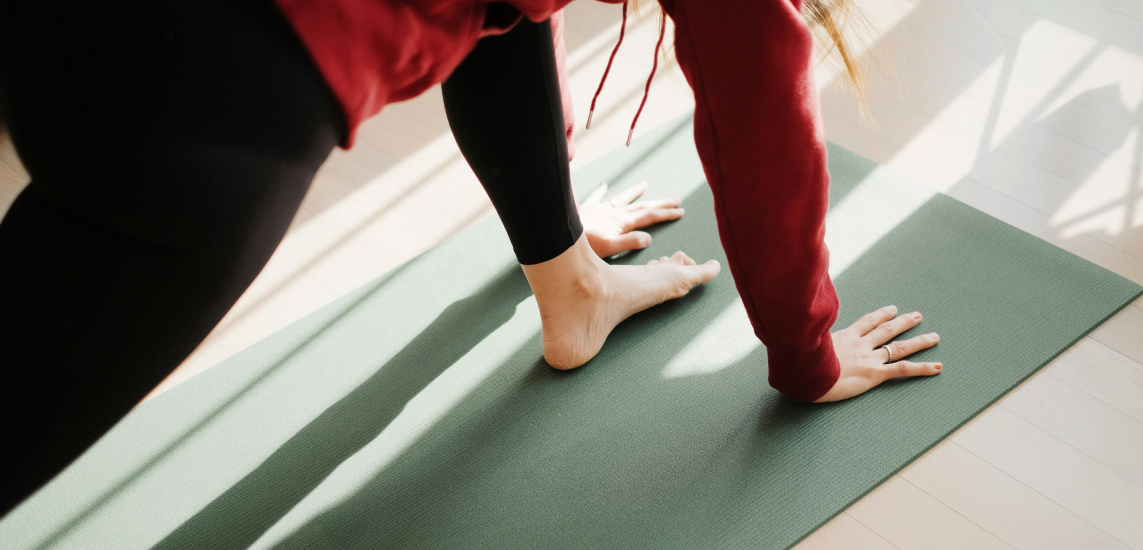Western thought believes that the body is separate from mind and emotion. But we can’t separate our bodies from our mental and emotional experiences — the mind and body are deeply connected. Emotions significantly impact our physical well-being. When we lose track of the bodily feelings that accompany our experiences, it can cause unconscious muscle tension.
In the best-selling book, The Body Keeps The Score, pioneering researcher Bessel van der Kolk confirms: Our bodies are reliable record keepers of our experiences, even if our minds tend to take precedence. They are truthful, they don’t mislead, and they don’t ignore our feelings. When we understand how our bodies affect our well-being, we have a deeper understanding of how our emotions are connected to the bodily strain we feel.
By understanding the connection between our feelings and our bodies, we can take steps to reduce muscle tension and improve our overall health. Acknowledging this connection is the first step in letting go of stress and stopping it from building up again.
Key takeaways
- Muscle tension is often a physical expression of emotional stress, anxiety, or trauma.
- Our bodies hold onto past experiences and emotions, leading to chronic muscle tension.
- Relaxation techniques, such as deep breathing, mindfulness meditation, and yoga, can help to reduce muscle tension and promote relaxation.
- Identifying and addressing the underlying causes of body tension is essential for long-term relief.
- Healthy lifestyle habits, such as eating a nutritious diet, getting enough sleep, and exercising regularly, can help prevent muscle tension from returning.
What causes muscle tension?
Muscle tension is a common condition characterized by tightness or stiffness in muscles, often leading to discomfort or pain. It is the force exerted when muscles contract. Unconscious muscle tension is our body’s response to the world around us — our emotions, like anxiety, influence our physical state, as explained in this article. This can lead to chronic muscle pain and tension, interfering with daily activities.
Strong emotions trigger a hormonal response in our bodies, causing our muscles to tense up. This instinctive reaction harks back to our early ancestors, who needed to react quickly to threats in their environment.
Our bodies, in essence, respond to the world by storing experiences as muscle tension.
Other causes
Muscle tension can worsen with increased frequency of muscle contractions. Muscle spasms that happen at random and without conscious control are known as dystonia. Physical, emotional, and lifestyle factors can cause involuntary muscle clenching.
Physical factors include:
- poor posture
- repetitive motions
- injuries
- medical conditions like arthritis or fibromyalgia
As an example, poor posture strains muscle groups, while, research shows, repetitive motions overwork muscles and cause soreness.
Lifestyle factors have an impact, too.
- lack of sleep
- poor nutrition
- smoking
- lack of adequate rest
More specifically, poor sleep prevents the body from repairing and rejuvenating muscles, increasing stress and discomfort. Poor nutrition results in muscle weakness. Smoking, which contains nicotine, constricts blood vessels, reducing blood flow to muscles and also leading to stress and pain.
How to reduce muscle tension: relaxation techniques
Fortunately, several effective relaxation techniques demonstrate how to release tension in the body and improve overall well-being.
Physical relaxation techniques
Diaphragmatic breathing: Diaphragmatic breathing effectively reduces muscle tension by increasing lung efficiency, reducing respiration frequency, promoting stress reduction, and promoting relaxation through full oxygen exchange and focus on the breath. If you want someone to guide you through the process, we have a growing selection of breathing meditations for you to get started.
Body scan meditation: Body scan meditation is a mindfulness practice that involves paying attention to your body’s sensations. By being aware of your body, you can address the muscle tension you have been holding in your body.
Mindful movement: Mindful movement is a type of exercise that combines physical activity with mindfulness. Research shows that these practices encourage us to tune into our bodies, be aware of the tension we carry, and learn how to release it. These studies show how mindful movement can teach us to be present in the moment, observe our emotions without judgment, and cultivate a sense of inner peace. Tai chi, yoga, and qigong are all examples of mindful movement practices.
Mindfulness-based stress reduction (MBSR) is an approach strongly supported by research. Movement is a key aspect of this approach. Get started today with one of our professionally guided MBSR practices.
Massage: Massage is a great way to relieve muscle tension and promote relaxation. Massage therapists use their hands to pressure your muscles, which helps break up knots and tension.
Mental relaxation techniques
Meditation: Meditation is a practice that involves training your attention and awareness. There are many different types of meditation, but all of them can help to reduce stress and anxiety, which can lead to decreased body tension.
Progressive muscle relaxation: Progressive muscle relaxation (PMR) is a technique that involves tensing and relaxing different muscle groups in your body. PMR effectively reduces muscle tension by breaking stress cycles, promoting physical and mental relaxation, and providing therapeutic benefits for various conditions through top-down and bottom-up processing in the nervous system.
- The Tension Release Meditation Vidyamala Burch 5:46
- Tension Release Manoj Dias 9:00
The mind-body connection
Language often mirrors our mind-body connection. We speak of a “heavy heart” when sad or feeling “tied up in knots” when anxious. These phrases are not just metaphors — they reflect the physical sensations that accompany these emotions. Emotional triggers like stress, anger, fear, and anxiety can raise blood pressure and cause muscle tension. The mind-body connection links thoughts, emotions, and physical health.
Our bodies have a remarkable capacity for memory. They record past experiences through muscle tension, remembering the physical sensations associated with those experiences. This is a testament to the interconnectedness of emotions and their buildup in body parts, underscoring the importance of understanding and managing our feelings to maintain physical health.
The intricate relationship between emotions and physical sensations is further emphasized when considering how the brain processes emotions in response to body expressions. Our brains constantly interpret bodily signals starting as early as 8 months old and they influence our emotional states throughout our lives. Maintaining a healthy mind-body connection is one of the best things you can do as part of your self-care practice.
Our natural stress response
Long-term stress has negative effects on our nervous system, which includes our nerves and the central nervous system. When we feel stressed, our bodies release hormones like cortisol and adrenaline, which can make our muscles tense up as if we were preparing to fight or run away, called the fight or flight response.
If stress continues for a long time, our bodies can maintain this muscle tension without us even realizing it. This keeps us on high alert, even when there is no immediate danger. Changes in hormone levels due to stress can affect how tense our muscles become. Unfortunately, this stress response isn’t just an adult problem. Research shows it affects us, even as kids.
On the other hand, activating the relaxation response, which is the opposite of the fight or flight response, helps us better handle and react to emotional and physical stress. Understanding this can help us manage stress better and improve our overall health.
Ready to master your stress? We’ve been there. Explore our library of stress meditations to find the perfect antidote for you.
What are the long-term effects of chronic muscle tension?
Pain is one of the most immediate effects of chronic muscle tension — soreness and ache, localized to the area of tension, or spread through parts of the body. Headaches are another common symptom, with tension in the neck and shoulders causing tension headaches.
Chronic muscle tension can also lead to fatigue, as muscles constantly work to stay tense, draining energy levels and leaving the body tired and worn out. Sleep disturbances can also occur, as discomfort from tense muscles makes it difficult to fall or stay asleep, leading to poor sleep quality and further fatigue.
This is not just something we have to “live with,” however. Research indicates that spirituality plays a crucial role in pain management and coping strategies for chronic pain sufferers. Spirituality, defined as “hope” in this research, can:
- mitigate stressors
- enhance resilience
- influence pain appraisals
By being spiritual and having hope, we experience less chronic pain and cope with pain better.
Find hope with a dedicated hope meditation track created by experienced teachers, spiritualists, or thought leaders.
Addressing underlying causes and prevention
To manage muscle tension and improve overall well-being, we need to identify triggers and develop strategies to prevent recurring issues. Identifying triggers involves identifying stressful situations, daily life activities, and emotional stress stored in our bodies. We can prevent triggers by learning healthy coping mechanisms and avoiding triggers if needed.
Importantly, a healthcare professional can help explore the underlying causes of muscle tension by assessing physical symptoms, medical history, and lifestyle. They can develop personalized treatment plans and guide you on how to manage stress and anxiety, including physical therapy, massage therapy, acupuncture, or medication. They can also direct you to counseling and support to help manage stress and ease anxiety, teaching relaxation techniques like deep breathing exercises, mindfulness, or yoga.
Mental health disorders such as generalized anxiety disorder (GAD) and panic disorder develop when the body’s stress response is triggered excessively. People with GAD frequently experience symptoms like:
- excessive worrying
- restlessness
- muscle tension
- fatigue
During a panic attack, individuals with panic disorder may experience muscle stiffness, leading to involuntary muscle rigidity even after the episode subsides. Seek guidance from a primary care physician or mental health professional who specializes in relaxation techniques to support relief for these conditions.
In an anxiety spiral? Take action now to stop an anxiety spiral with our tips.
Healthy coping mechanisms for stress and anxiety can include:
- exercise
- meditation
- spending time in nature
- talking to a friend or family member
- anything that calms and relaxes you!
Mindfulness interventions, which focus on the present moment without judgment, have been proven to be particularly effective in reducing muscle tension and improving overall well-being. Mindfulness helps us become more aware of our body and thoughts and develop healthier coping mechanisms for dealing with stress.
Connect your body and mind and reduce muscle tension
To reconnect, we must listen to our bodies’ stories. If we understand them, they’ll guide us toward emotional release and healing. Remember, your body is your ally, its tension a compass pointing you toward true healing. Embrace its wisdom and discover a path to greater well-being and harmony.
Tools like Insight Timer provide mindfulness practices, particularly in investigating attention and awareness during meditation.
FAQs about unconscious muscle tension
What is the mind-body connection?
The mind and body are deeply connected, and our emotions can significantly impact our physical well-being. Muscle tension is often a manifestation of emotional stress, anxiety, or trauma.
How can emotions lead to muscle tension?
When we experience intense emotions, our bodies release hormones that can cause muscles to tense up. For example, stress can trigger the release of cortisol, leading to back pain or tension in the neck and shoulders.
How can I identify the underlying causes of my muscle tension?
To identify the underlying causes of your muscle tension, pay attention to your emotions and any physical or emotional stressors you may be experiencing. Consider keeping a journal to track your muscle tension and any potential triggers.
What are some effective relaxation techniques for reducing muscle tension?
Many effective relaxation techniques, such as deep breathing, meditation, and yoga, can help reduce muscle tension. You can also try gentle stretching or massage.
How can I prevent muscle tension from coming back?
Managing stress levels, getting enough sleep, and exercising regularly are essential to prevent muscle tension from returning. Consider incorporating relaxation techniques into your daily life.
Disclaimer: This article is for information only and should not be considered as medical advice. If you have concerns about anxiety or any other conditions mentioned in this article, please seek a medical professional for help.
References
- Alfven, G., Grillner, S., & Andersson, E. (2019). Review of childhood pain highlights the role of negative stress. Acta Paediatrica, 108(12), 2148–2156. https://doi.org/10.1111/apa.14884
- Correia, M. A., Corrales, M. A., McLachlin, S. D., & Cronin, D. S. (2023). Effect of muscle pre‐tension and pre‐impact neck posture on the kinematic response of the cervical spine in simulated low‐speed rear impacts. International Journal for Numerical Methods in Biomedical Engineering (Print), 39(11). https://doi.org/10.1002/cnm.3761
- Ferreira-Valente, A., Damiao, C., Pais-Riberio, J., & Jenson, M. (2019, May 2). The Role of Spirituality in Pain, Function, and Coping in Individuals with Chronic Pain. Pain Medicine; Oxford Academic. https://academic.oup.com/painmedicine/article/21/3/448/5482550
- Greeson, J. M., Juberg, M. K., Maytan, M., James, K., & Rogers, H. (2014). A Randomized Controlled Trial of Koru: A Mindfulness Program for College Students and Other Emerging Adults. Journal of American College Health, 62(4), 222–233. https://doi.org/10.1080/07448481.2014.887571
- Liu, Y.-Z., Wang, Y.-X., & Jiang, C.-L. (2017). Inflammation: The Common Pathway of Stress-Related Diseases. Frontiers in Human Neuroscience, 11(316). https://doi.org/10.3389/fnhum.2017.00316
- Missana, M., Atkinson, A. P., & Grossmann, T. (2014). Tuning the developing brain to emotional body expressions. Developmental Science, 18(2), 243–253. https://doi.org/10.1111/desc.12209
- Schneider, J., Malinowski, P., Watson, P. M., & Lattimore, P. (2018, November 23). The role of mindfulness in physical activity: a systematic review. Obesity Reviews. https://doi.org/10.1111/obr.12795
- Woodyard C. (2011). Exploring the therapeutic effects of yoga and its ability to increase quality of life. International Journal of Yoga, 4(2), 49–54. https://doi.org/10.4103/0973-6131.85485
- Van der Kolk, B. (2014). The body keeps the score: brain, mind and body in the healing of trauma. Penguin Books.







